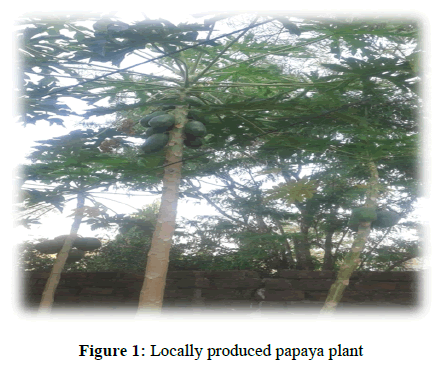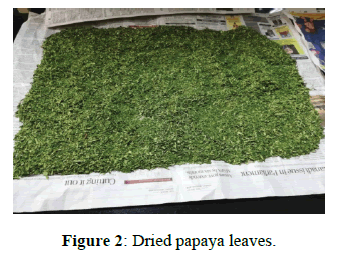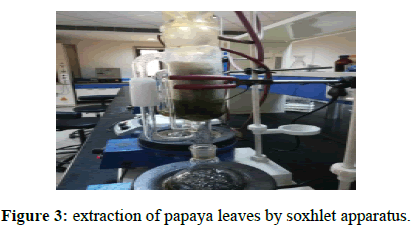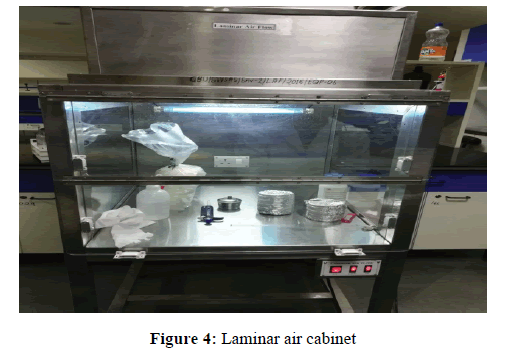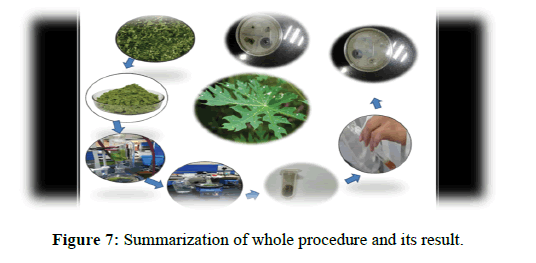Research Article - Der Pharma Chemica ( 2020) Volume 12, Issue 5
Extraction, Phytochemicals Screening and Antibacterial activity of Carica papaya Leaf Extracts
Seema Kumari and Jaya Maitra*Jaya Maitra, Department of Applied Chemistry, School of Vocational Studies and Applied Sciences, Gautam Buddha University, Greater Noida, U.P, 201310, India, Email: jaya1100@rediffmail.com
Received: 10-Aug-2020 Accepted Date: Aug 19, 2020 ; Published: 31-Aug-2020
Abstract
Carica papaya is a domestically produced plant and it is an accepted medicinal plant which is used traditionalistic and domesticated in India and tropical area of this world. The present study describes phytochemical constituent of Carica papaya leaves and its antibacterial screening. Fresh leaves sample were collected during the month of February, 2018 from Gautam Buddha University and Dadri (UP), India. The purpose of the study was the effect of different solvent and different method on the yield of the bioactive compounds of the papaya leaves growing in the semiarid region of Uttar Pradesh. Grinded leaves of papaya were extracted using different sovent i.e., n-hexane, PET, water, alcohol (ethanol, methanol), hydroalcohol (water+methanol) and the extraction was done by different technique soxhlet, as well as microwave assisted extraction technique. Many of these phytochemicals have amazing effects on long-term health when consumed by the human and can be efficaciously used to treat human diseases. The TLC analysis and phytochemical screening was carried out using standard methods and protocols. This study demonstrates that the microwave assisted extraction technique is better than soxhlet technique it also shows that hydro-alcoholic leaf extract of papaya gives better yield by microwave assisted extraction method and extracted leaves extract also shows the antibacterial activity against E. coli and Bacillus subtilis.
Keywords
Carica papaya (C. papaya), Phytochemicals, Soxhlet technique, Microwave assisted extraction technique, E. coli and Bacillus subtilis
Introduction
C. papaya commonly known as Papita belongs to the family Caricaceae (Figure 1). The papaya is a big, tree-like flora, with a single hollow trunk growth from 6 to 12 m (15 to 33 ft) tall, with centrifugal arranged leaves bound to the top of the trunk. The leaves are large, 50 cm–70 cm, deeply multilateral, with seven lobes. The flowers and fruits appear on the axils of the leaves, maturing into large fruit, 10 cm–40 cm long and 10 cm–30 cm in diameter [1]. C. papaya leaves are used as a green tea for the treatment of malaria in some parts of the world Mature leaves are bitter in taste. They comprise the bitter alkaloids, carpaine and pseudocarpaine, which effect on the heart and respiration like digitalis, but are destroyed by heat. C. papaya was traded throughout America by the Spanish and Portuguese from the 16th century. It is originating from Mexico and their native area but today’s it is cultivated in tropical and subtropical countries i.e., India, America, Africa, China Bangladesh, Florida, Peru, and Thailand. At present the main issue is the development of multi antibiotic resistance in the pathogens [2]. Plants consists of phytochemicals which are responsible for various pharmacological activity but when we extract the bioactive component of plant with different methods the yield and the efficacy of its pharmacological activity can be affected hence there is a need to recuperate the methods of extraction and herbal formulations for the current exigency C. papaya leaf extracts. The leaves of papaya contain many active components that can increase the total antioxidant power in blood and reduce lipid peroxidation level, due to the presence of papain, chymopapain, cystatin, tocopherol, ascorbic acid, flavonoids, cyanogenic glucosides and glucosinolates [3] which have various therapeutic properties like antiplatelet, anticancer, anti-inflammatory, anti-tumour activity etc. [4] Reports on different topic of Carica papaya have been published, but still a comparative study is to be needed to study the difference in medicinal values of this plant growing in different climatic region like Greater noida. Here the attempt has been done to study the phytochemical constituents of leaves of C. papaya. The objective of the study was to evaluate the best method to extract constitutions in the leaf of C. papaya growing in semi-arid region of Uttar Pradesh (Greater Noida).
Materials and Methods
Materials Required
Carica papaya leaves, Ethanol, Water, PET, Hexane, Methanol, HCl, Mayers reagent, NaOH, FeCl3, CHCl3, H2SO4, Pyridine, Sodium nitroprusside. The origin of all the chemicals is CDH.
Preparation of sample
Carica papaya leaves were collected from GBU campus, Greater Noida, UP in February 2018 during winter season and the leaves were mature green, yellow and immature also. The leaves were washed with tap water and distilled water respectively and sliced into small pieces and dried the leaves at room temperature for 7-8days and kept in hot air oven at 50°C for 2 hours (Figure 2). The dried leaves were ground to fine powder with the help of grinder and the powdered sample was kept in clean closed containers till extraction.
Extraction by Soxhlet apparatus
The extraction was done by soxhlet apparatus using different solvent i.e., ethanol, methanol, n-hexane, water, and water + methanol (30% methanol) respectively by using the scheme 1. The quantity of leaf powder and the solvent was 40 g and 250 mL respectively for all the solvent used for different extracts (Figure 3).
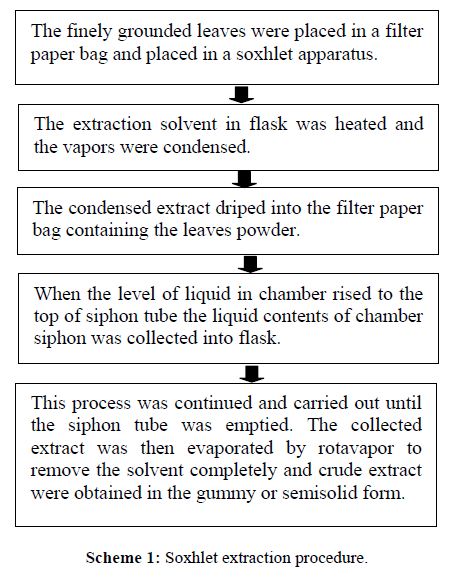
Extraction by Microwave assisted extraction technique
The extraction was done by Microwave assisted extraction technique, using different solvent i.e., ethanol, methanol, n hexane, water, and water + methanol respectively by using the scheme: 2 mention in above part.
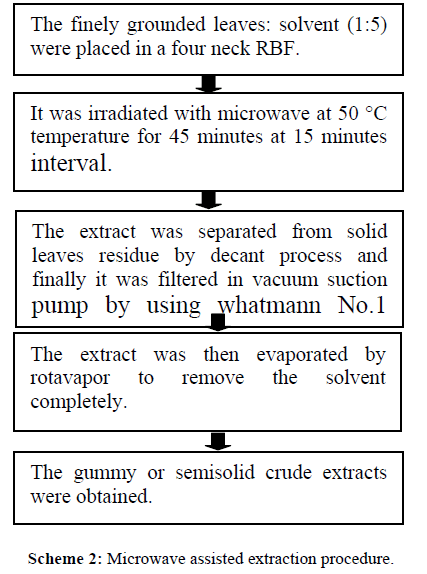
Phytochemicals screening of the C. papaya leaf extracts
The different solvents extract of C. papaya leaves were phytochemically screened in order to determine the presence of naturally occurring substances or secondary metabolite in the leaves of the C. papaya plant by using the procedure mention in Table 1.
Table 1: Phytochemicals screening [5-7].
| Phytochemicals | Test | Reagents | Inference |
|---|---|---|---|
| Alkaloids | Mayer’s test | 1% HCl, Mayers reagent (potassium-mercuric iodide ) | Cream colur ppt obtained |
| Flavanoids | Alkaline test | HCl, | Yellow colour appear |
| 20% NaOH | |||
| Tannins | Ferric chloride test | 5% FeCl3 | Blue-green colour |
| Saponins | Foam test | Distilled water | Persistent foaming |
| Steroids | Salkow-aski Test | CHCl3 , H2SO4 | Formation of yellow colour |
| Glycoside | Legal test | Pyridine (C5H5N) | Red colour produced |
| Sodium nitroprusside | |||
| Na2[Fe(CN)5NO] |
Thin layer chromatography (TLC)
Thin layer chromatography: Thin layer chromatography (TLC) was carried out for methanol, ethanol, methanol water, and n-hexane extracts of C. papaya leaf on TLC precoated plates. The extracts of leaf of C. papaya were spotted at 1.6 cm above from the bottom of the TLC plate. The chromatogram was developed in a mixture of suitable solvent system i.e., benzene and PET (1:1). The spots were visualized in iodine chamber. The Rf values of the coloured spots were recorded.
Rf = Distance travelled by solute / Distance travelled by the solvent
Antibacterial screening of C. papaya leaf extract
Principle
Bacteria are responsible for many diseases. The drug-resistant bacterial pathogens and the increasing clinical essence of the drug have lent additional urgency to antibacterial drug research. The antibacterial screening, which is the first stage of antibacterial drug research, is performed to ascertain the susceptibility of various bacteria to any agent. This test measures the ability of each test sample to inhibit the bacterial growth. This ability may be estimated by various methods i.e., disk-diffusion, well diffusion and broth or agar dilution flow cytofluorometric and bioluminescent methods Agar well diffusion method is a widely accepted screening of test agents, which may possess antimicrobial activity. It is most importantly a quantitative or qualitative procedure indicating the sensitivity or resistance of the microorganisms to the test samples but it does not used to distinguish the bacteriostatic and bactericidal activity of the test sample [8].
Reagent and Apparatus Required
Sample: Concentrated Crude Extract of C. papaya (leaf), Bacterial Culture: Bacterial strain, Luria Bertani Broth Miller’(Hi-media), Ethanol, Laminar Air Flow Cabinet (Figure 4), Incubator, Autoclave, Hot Air Oven, Micropipette, Micropipette Tips, Petri dishes, Spreader, Filter paper, Sprit lamp.
Test Organisms
The microbial strains of both gram-positive, gram-negative bacteria were used for the experiment were collected as pure cultures from School of Biotechnology “Gautam Buddha University” Greater Noida.
Experimental Procedure
Media preparation and sterilization
The composition of the supplied agar medium and broth was 40g, 25g per 1000 mL respectively 4 g nutrient agar and 2.5 g broth was weighted and taken in the 250 mL and added 100 mL of water to make agar solution and broth solution. Then conical flask was covered with cotton plugs and put in autoclave machine at a temperature of 121ºC for 15 minutes at about 1 hr for sterilization.
Sterilization of Tips
The micropipette tips were placed in autoclave machine at a temperature of 121ºC for 15 minutes at about 1 hr for sterilization.
Preparation of culture
In a laminar air cabinet, the test organisms were transferred from the pure cultures to the broth solution at room temperature with the help of micropipette. The conical flask was shaken by rotation to get a uniform suspension of the organisms and incubated for
24 hours at 37ºC for their optimum growth. These cultures were used for the sensitivity test.
Preparation of Agar plates
According to the type of bacteria Petri dishes were marked. Agar medium was poured into each Petri dish to get 4 mm depth of agar media each. After pouring the agar medium, all Petri dishes were kept in room temperature so that the medium can properly solidify and the plate was stored at 40oC for further procedure.
Extract Solution Preparation
The solution of samples was prepared and diluted for a minimum concentration.
Preparation of Test Plate
In a laminar air cabinet (Figure 4) the bacterial suspension was transferred on agar plate by micropipette (100 μL-1000 μL) on the solidified agar plate. The volume of the bacterial suspension was spreaded over the entire agar surface for inoculating. Then, a well was made by a microtip, and a volume (20 μL-100 μL) of the prepared extract solution at desired concentration was introduced into the well. Then, agar plates were kept in an incubator for 24 hours at 37oC. The antimicrobial agent diffuses in the agar medium and inhibits the growth of the bacterial strain tested.
Determination of Antimicrobial activity by measuring the Zone of Inhibition
The antibacterial activity of the test agents was observed by their activity to prevent the growth of the microorganisms surrounding the well which gives clear zone of inhibition.
Conclusion
This study report will help the existing knowledge regarding Carica papaya leaves to develop a drug and take part in the various herbal formulation containing leaves as main ingredients. This information can be useful in determining the type of compounds present in papaya leaf as well as set the standards for future researches from the particular region i.e Greater Noida, UP. The summary of whole experiment of this study is shown in Figure 7.
References
[1] N. Pravin Ram, R. Vijay Ram, T. Taslimahemad et al., International Letters of Natural Sciences., 2014, 19: p. 15-24.
[2] Kaliyaperumal Karunamoorthi, Hyung-Min Kim, Kaliyaperumal Jegajeevanram. Tang Humanitas medicine., 2014, 4(1): p. 1-17.
[3] DS. Seigler, GF. Pauli, A. Nahrstedt. Phytochemistry., 2002, 60(8): p. 873-82.
[4] Noriko Otsuki, Nam H. Dang, Emi Kumagai. Journal of Ethnopharmacology., 2010, 127(3): 760-767.
[5] J. Vyas Suhas, T. Khatri Taslim, R. Ram Vijay, International Letters of Natural Sciences Online., 2014, 12: p. 16-20.
[6] EJ. Alorkpa NO. Boadi, M. Badu., 2016, 4(6): p. 193-198.
[7] Hossain Nusrat, Kumar Palanirajan Vijayaraj, Wei Yeong Siew et al., Int. J. Green Pharm., 2016, 10(1): p. 72-81.
[8] Adejuwon, Agbaje., Int. Res. J. Microb., 2011, 2(3): p. 512-515.

